One of the challenges in life, and yoga, (hopefully you are at a point where these are one and the same!) is that growth requires change, and most of us are ambiguous about change. (There’s that word ‘ambiguous‘ again.) Change that makes us feel better – bring it on! Change that makes us frustrated, uncomfortable or confused: no thank you. The reality of growth is that when moving to a new level of integration, whether horizontally or vertically, what worked previously (the level of precision, openness, integration) will probably not be enough to function at the next level. Which means you have to go back to being a beginner, and if your ego has become attached to being ‘successful’, it will want nothing to do with the ‘failing’ to live up to the egoic self image’ that growth requires. Your ego will be quite content to stay stuck.
(A simple example of horizontal integration: as an English speaker, I can increase my vocabulary and understanding of grammar, and learn to express myself in prose or poetry, or in writing. With vertical integration: I learn a whole new language, or multiple languages or study linguistics.)
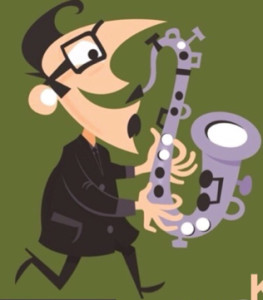 After 18 months on the alto, I have finally leaned to, in very basic terms, use the full range of the horn, including a few of the more challenging altissimo notes. The middle notes are the easiest, but it took a while to find depth and fullness in the lowest notes and even get any sound in the very high ones, but I made it. So what does my dear teacher Karl Hunter do? He asks me to quickly go from high to low, or low to high and back, just to see what might happen. Yikes. Horrible sounds, total loss of tone. Lots of confusion. Feelings of embarrassment.
After 18 months on the alto, I have finally leaned to, in very basic terms, use the full range of the horn, including a few of the more challenging altissimo notes. The middle notes are the easiest, but it took a while to find depth and fullness in the lowest notes and even get any sound in the very high ones, but I made it. So what does my dear teacher Karl Hunter do? He asks me to quickly go from high to low, or low to high and back, just to see what might happen. Yikes. Horrible sounds, total loss of tone. Lots of confusion. Feelings of embarrassment.
My diagnosis? I had good yin for the low and good yang for the high, but they were not in a healthy relationship. Or to say it slightly differently, there was not a stable center uniting the two extremes. Not to get too technical, but the pelvic floor, diaphragm, ribs, throat cavity, tongue and muscles of the mouth (embouchure, from the French word for mouth) have to be both stable (sthira) and flexible (sukham, in the right relationships. My embouchure was unstable, overcompensating to help hit the high and low notes. Parts that should be moving were stuck, and parts that should have stablized (not rigidly) flopped about. So I have to go back to being a beginner and relearn this, by finding a stable and flexible embouchure center (high A flat) and sustaining this as I go up and down, adjusting other inner muscles and tissues.
This is, amazingly enough, the same story in yoga. Many years ago, I was able to push myself into deeper backbends and forward bends, through will power and persistence, but when, over a short period of time I met Bonnie Cohen, Emilie Conrad and Caryn McHose, three teachers who totally embodied flow, I was at a total loss trying to feel what they were trying to teach me. (At the 1990 Backbend Intensive in Pune, Iyengar used me as the 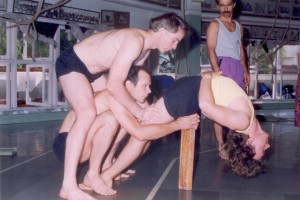 ‘poster boy’ for how ‘not to do’ backbends. He was also trying to penetrate my overly dense energy field, but I was clueless. Here is Iyengar’s creative way to awaken CV-1, the seat of the yin, and to relax the kidneys to balance the intense yang of the pose. In spite of the help my my Aussie buddies Peter Thompson and John Leebold, I wasn’t there yet.)
‘poster boy’ for how ‘not to do’ backbends. He was also trying to penetrate my overly dense energy field, but I was clueless. Here is Iyengar’s creative way to awaken CV-1, the seat of the yin, and to relax the kidneys to balance the intense yang of the pose. In spite of the help my my Aussie buddies Peter Thompson and John Leebold, I wasn’t there yet.)
I realized that I had to ‘unlearn’ many habits, slow down and learn to listen. This is the feminine or ‘yin’ side of asana, that when awakened, revolutionized my inner world. Amazingly enough, but using way more ‘yin/water’ and way less ‘yang/fire’, I began to feel what Iyengar had been trying to teach me and my understanding of the world he inhabited began to open. However, it took many more years for the kidney/water relationship to awaken. Yoga is an ever evolving process.
It is important for a beginner in yoga to realize that there are stages in the evolution of sensitivity. Not all go through the phases at the same speed, but you cannot skip any levels, and you need to deeply absorb the lessons of each in order to keep growing. Growth is a spiral rather than a straight line, so going backwards are re examining previous levels can lead to deeper understanding.
The first step in the modern world this is moving from being ‘thought’ centered to ‘body’ centered. ( Is this right? – How does it feel?- I don’t know, can’t you just tell me what I’m supposed to feel?) This is a big leap for most. Your new center of balance is no longer an idea or memory, but information coming directly from the body. There is still a strong tendency for the mind to grip the tissue because it does not know of any other way to find it. This is overworking, a rajasic action, but at least your in the body. And the tendency to use thought or memory as the root of the action will be strong for a while. But over time, if you can relax a bit, you will begin to notice when the body ‘feels right’. and the body will begin to become the teacher. This will evolve as you become more sensitive to ”too tight, too loose, just right”.
Over time, if you want to become an intermediate level student, you have to be willing to change again. This time, from being centered (and probably attached to the wonderful job you are finally doing) in muscles and bones, objects the mind can grasp onto, you have to find the ungraspable but definitely perceivable sense of flowing energy. Here you begin to find a  new center of balance by exploring what Patanjali calls the ‘dvandvas‘, and what we are calling here as yin and yang. As you feel flow and become flow, you begin to recognize blockages as information to be studied and food for growth, not obstacles to overcome. The dualistic mind sees obstacles as ‘other’, in the way of ‘me’ feeling good about myself. When you recognize these dualistic mind states and voices as the roots of suffering, you can turn them into your allies by honoring their deep desire to protect you, but finding other ways that they can be of service. Send them to apprentice with Ganesha, or some other cosmic defender, where they can learn how to become ‘non-dual’ protectors. This make take a awhile, and a good psychotherapist can be very helpful, but then you’ll be able to handle the next shift with grace and lightness.
new center of balance by exploring what Patanjali calls the ‘dvandvas‘, and what we are calling here as yin and yang. As you feel flow and become flow, you begin to recognize blockages as information to be studied and food for growth, not obstacles to overcome. The dualistic mind sees obstacles as ‘other’, in the way of ‘me’ feeling good about myself. When you recognize these dualistic mind states and voices as the roots of suffering, you can turn them into your allies by honoring their deep desire to protect you, but finding other ways that they can be of service. Send them to apprentice with Ganesha, or some other cosmic defender, where they can learn how to become ‘non-dual’ protectors. This make take a awhile, and a good psychotherapist can be very helpful, but then you’ll be able to handle the next shift with grace and lightness.
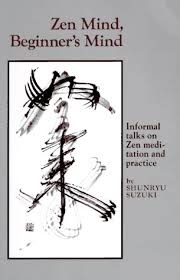 Finally, the mature student has to make the leap to the non-dual vision where you discover the oneness of all the relational fields of overlapping energy waves and flows, from the quantum fields to the galactic clusters, all dancing together, and the infinite stillness at the Source. And this arrival is not the end, but another beginning, where, as best you can, in your very human way, you unfold the unique vision of your soul into the world around you, through as many layers and levels of reality you have time and energy for. Here you are an eternal beginner, embracing ambiguity, tumbling in turmoil, accepting your humanness, open to whatever comes your way as your teacher, as gift from the hidden realms to help you further awaken.
Finally, the mature student has to make the leap to the non-dual vision where you discover the oneness of all the relational fields of overlapping energy waves and flows, from the quantum fields to the galactic clusters, all dancing together, and the infinite stillness at the Source. And this arrival is not the end, but another beginning, where, as best you can, in your very human way, you unfold the unique vision of your soul into the world around you, through as many layers and levels of reality you have time and energy for. Here you are an eternal beginner, embracing ambiguity, tumbling in turmoil, accepting your humanness, open to whatever comes your way as your teacher, as gift from the hidden realms to help you further awaken.
Practice:
Kidneys represent/are the innate intelligence of water in the universe, manifesting as the source of life on planet Earth. Water has weight, so it immediately and clearly responds to gravity, giving us a sense of down and grounding. But water is ungraspable. It flows through your fingers, so you need a container. In our somatic explorations, the body is an obvious container, but so are the collective ideas and beliefs we hold. A healthy container is flexible and dynamic, listening to the water intelligence and learning. Our body/container has three major segments, head, chest and abdomen/pelvis, along with four limbs connected to the core. As the water element is yin, we need to awaken the lower regions to help find the kidneys, and for this we go right to the soles of the feet.
 In standing, find the Kidney-1 points on the soles of your feet and relax down. Find what I call ‘skiers’ tadanasa, where your legs are engaged, relaxed, flexible and adaptable. The is the stance of the athlete, being ‘on your toes’, although toes is not the best description. But you can feel this. For beginners, through very mature bodies, return here again and again, until the region is awake. Learn to move from here, and when standing still, re-engage, again and again.
In standing, find the Kidney-1 points on the soles of your feet and relax down. Find what I call ‘skiers’ tadanasa, where your legs are engaged, relaxed, flexible and adaptable. The is the stance of the athlete, being ‘on your toes’, although toes is not the best description. But you can feel this. For beginners, through very mature bodies, return here again and again, until the region is awake. Learn to move from here, and when standing still, re-engage, again and again.
Water represents flow, and in the body, water needs to circulate. K-1 is also known as the bubbling spring, as it is where we begin to feel the water returning to the heart in what is called circulation. The elasticity in the joints and tissues of the feet and legs, gently and rhythmically flexing and extending, acts as a pump. The structure has rhythm, the heart has a rhythm, the breathing has a rhythm, and the kidneys help co-ordinate this dance of life. Kidney yin flows down helping the blood flow into the lowest muscles and tissues. The kidney yang helps the blood, lymphatic and extra-cellular fluids find their way back to the heart. Feel as relaxed and suspended as the kelp shown above, and follow the flow of fluids through your body.
The breathing pump can be easily felt sitting.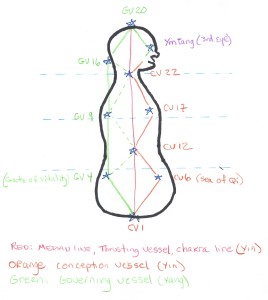 Sitting upright, without strain, let the breathing drop down into the belly, as if the lower body is a basin or cauldron that has a weighty presence, but receives the breath by expanding and condensing, like a hoberman sphere.
Sitting upright, without strain, let the breathing drop down into the belly, as if the lower body is a basin or cauldron that has a weighty presence, but receives the breath by expanding and condensing, like a hoberman sphere.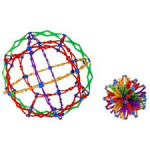 Once you can feel the gentle movement, visualize your kidneys gently dropping on the in breath, gently rising on the out breath.
Once you can feel the gentle movement, visualize your kidneys gently dropping on the in breath, gently rising on the out breath.
In evolution and embryology, the single cell action of the sphere elongates to become a tube, giving birth to a mouth and anus, and eventually to a head and tail. Using the points in the center, you can begin to elongate from spherical to tubular consciousness. Imagine your kidneys are suspended from CV-12, CV-22 or even GV-20 if your imagination and perception allow, and let them feel the breath. Yesterday while swimming in the local pool, I imagined my two kidneys were two blue dolphins undulating along inside of me. Their presence helped change the shape of my feet. (The flippers helped as well.)
Eventually, the kidneys find their center, from which the up and down movements are easy and effortless. The reality is that, because the K-1 loop through the legs is not integrated, we overwork the erector spinae muscles at the back and the psoas along the front of the spine to maintain our upright position. This unnecessary tension, or ‘gripping’ in the tissues will inhibit the kidney motility. Finding the inner flow, with help of the GV-4 to release to erectors and CV-6 to release the psoas, and then integrating with the K-1 loop through the feet and legs creates a powerful core support that is fluid based, and thus adaptable. This adaptable support allows you to change postures without losing the kidney/fluid body support.
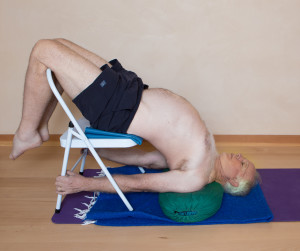 As the lower body center becomes fluid, adaptable and strong, it can be used to help open the chest cavity through the increasing elasticity of the diaphragm. The supported poses add a yin quality to help prevent overworking, but the supports are not an invitation to ‘hang out’ in the pose. Here, with yin and yang reversed, gravity becomes an ally to help expand the diaphragm. The yin still flows down, but now it goes toward the yang instead of away as when upright. The legs stay engaged to keep the K-1 to CV-1 (seat of the yin) compartment open, which allows the lower belly area to breathe and the kidneys to stay fluid. Still some work to do at CV-22, but the bolster is helping the area slowly open more.
As the lower body center becomes fluid, adaptable and strong, it can be used to help open the chest cavity through the increasing elasticity of the diaphragm. The supported poses add a yin quality to help prevent overworking, but the supports are not an invitation to ‘hang out’ in the pose. Here, with yin and yang reversed, gravity becomes an ally to help expand the diaphragm. The yin still flows down, but now it goes toward the yang instead of away as when upright. The legs stay engaged to keep the K-1 to CV-1 (seat of the yin) compartment open, which allows the lower belly area to breathe and the kidneys to stay fluid. Still some work to do at CV-22, but the bolster is helping the area slowly open more.
Here is essentially the same pose but now were back in the ‘normal’ relationship to gravity. The K-1 points are very actively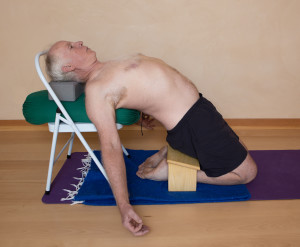 pressing down and CV-1 is strongly lifting to release the kidneys down toward the lower belly. Then the fluid/organ energy comes dynamically up into the diaphragm, going against gravity. The pressure inside the abdominal area is positive or outgoing and needs to be channeled into legs as grounding and into the diaphragm as chest lifting/expanding. The internal pressure of the chest is negative or inward and if the ribs can expand, the abdominal energy will be pulled upward from above by the negative pressure created as well as being pushed from below. This creates a powerful balance and integration that becomes effortless over time.
pressing down and CV-1 is strongly lifting to release the kidneys down toward the lower belly. Then the fluid/organ energy comes dynamically up into the diaphragm, going against gravity. The pressure inside the abdominal area is positive or outgoing and needs to be channeled into legs as grounding and into the diaphragm as chest lifting/expanding. The internal pressure of the chest is negative or inward and if the ribs can expand, the abdominal energy will be pulled upward from above by the negative pressure created as well as being pushed from below. This creates a powerful balance and integration that becomes effortless over time.
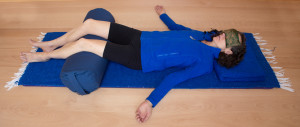 At the end of your practice, the bolster can be used to help relax and awaken the kidneys. Place yourself carefully and use your hands to adjust the buttock flesh down, but do not over tuck. Drop the femur heads, let the sacrum float up, and feel the kidneys breathing. Drop the brain, feel the kidneys feeding the heart, and then rest in the stillness.
At the end of your practice, the bolster can be used to help relax and awaken the kidneys. Place yourself carefully and use your hands to adjust the buttock flesh down, but do not over tuck. Drop the femur heads, let the sacrum float up, and feel the kidneys breathing. Drop the brain, feel the kidneys feeding the heart, and then rest in the stillness.

